
HOME
INTRO
SYMBOLS
ALMANAC
ECONOMY
GEOGRAPHY
STATE MAPS
PEOPLE
FORUM
NEWS
COOL SCHOOLS
STATE QUIZ
STATE LINKS
BOOK STORE
MARKETPLACE
GUESTBOOK
CONTACT US


You may double left-click on a word on this page to retrieve its definition. Tweet Follow
New York State Tree
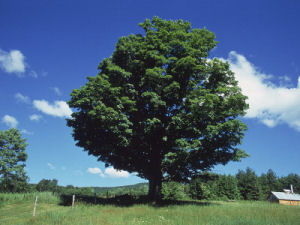
New York State Tree: Sugar Maple
Photographs, prints, posters
In 1889, school children from schools across New York state were solicited to express their preference for an official state tree. The young students made their preference known and the sugar maple was lauded as the state tree of New York.
The sugar maple remained in a place of prominence among New Yorkers for sixty years. In spite of the favorable 1889 vote by school children, the sugar maple never received an "official" designation from the state legislature. Proponents of the red oak sought to take advantage of that fact. In 1949 a challenge emerged with a legislative proposal to name the red oak the official state tree.
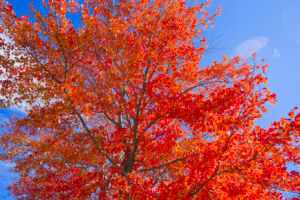
New York State Tree: Sugar Maple (Autumn color)
Photographs, prints, posters
It looked like New York's long affair with the sugar maple might be upset by an "official" act of the New York State Legislature. The oak tree seemed to be riding a wave of popularity. Maryland had adopted the white oak in 1941 commemorating its huge Wye Oak, at Wye Mills, on the Eastern Shore. Connecticut had adopted the white oak, in 1947, in recognition of its historic Charter Oak.
Though supported by tree lovers and nurserymen, legislation designating the stately red oak (Quercus borealis) the official state tree failed to win approval by the legislature.
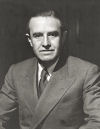
New York Governor
Averell Harriman
Nine years later, in 1956, New York Governor William Averell Harriman asked the State Assembly to validate the choice the school children had made in 1889. He asked the legislature to officially designate the sugar maple the official state tree of New York.
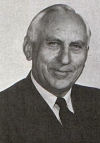
Vermont Governor
Joseph Johnson
When Vermont Governor Joseph B. Johnson heard about the proposal to name the sugar maple New York's state tree, he sent a rather confrontational telegram to New York Governor Averell Harriman expressing outrage that New York would even consider naming the sugar maple their official state tree.
Johnson telegraphed a protest that "the sugar maple has been the state tree of Vermont since March 16, 1949, and the public won't be fooled into believing that the Empire state can compete with Vermont maple products."
"However, Vermont will be willing to share its sugar maple with New York if you are willing to prove in competition that New York's maple- products taste even one-half as good as Vermont's maple products."
("Vermont-N.Y. Maple Syrup Battle Simmering to Boil", 1956)
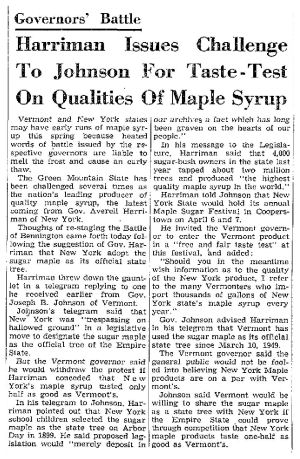
Bennnington Evening Banner Tuesday, January 24, 1956
In the telegram, Governor Johnson accused New York of "trespassing on hallowed ground" but offered to withdraw his protest if Harriman admitted that New York's maple syrup tasted only 'half as good as Vermont's." [2]
Harriman promptly challenged Johnson to enter Vermont's maple sugar in a "free and fair taste test" at the annual New York State Maple Sugar Festival in Cooperstown April 6-7.
"Should you in the meantime wish information as to the quality of the New York product," Harriman added, "I refer you to the many Vermonters who import thousands of gallons of New York state's maple syrup every year."
("Vermont-N.Y. Maple Syrup Battle Simmering to Boil", 1956)
And, Harriman pointed out, New York school children had already selected the sugar maple as the state tree on Arbor Day in 1889! The current legislation, he said "merely deposit in our archives a fact which has long been graven on the hearts of our people." [1]
In the New York State Assembly, legislators were up in arms.
"Gentleman, this is war!" declared Assemblyman Eugene F. Bannlgan. [2]
From Vermont came further assaults on New York's actions.
- To capture Vermont's prestige as the state producing the best quality maple syrup you must step up the standards of your own state.
- You must overcome a tradition that goes back perhaps to 1910 when the national standard for syrup was based on Vermont quality.
- You must overcome the pace set and held year in and year out by Vermont as the leading producer of maple syrup.
- You must recognize that Vermont is the only state that has compulsory grade labeling laws with teeth.
- You must accept the fact that Vermont soil and climate are considered best for producing best quality syrup.
During a speech in Worcester, Massachusetts, Vermont Governor Johnson accepted Harriman's challenge and agreed to a face-off at the New York State Maple Sugar Festival in Cooperstown.
The field of "maple war" competitors was growing. New Hampshire, Maine, Ohio and the Province of Quebec, Canada joined what some called a "good-natured feud."
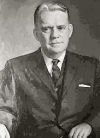
New Hampshire Governor
Lane Dwinell
The Governor of New Hampshire, Seymour Lane Dwinell, upped the ante.
Governor Durnell [sic] says both Harriman and Johnson "are way out on a maple limb." Both governors, he said, "are trying to borrow New Hampshire's reputation for producing the highest quality maple syrup."
("Cooperstown Invites Governors to Fete", 1956)
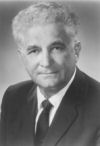
Ohio Governor
Frank Lausche
From Ohio, Governor Frank John Lausche weighed in.
The cry reached the ears of Governor Lausche, who replied in a letter to a New York lawmaker "You can save yourself a lot of anxiety and bring to an end this dispute by recognizing that while the maple syrup of New York, the New England states and Quebec is good, that of Ohio is the finest in the world."
("Vermont Maples are Tops Says GVA's Ansheles", 1956)
New Hampshire State Representative Perkins Bass proposed that un-biased commission be appointed to pass judgment on each state's product, then went on mock the proposition that any other product could match the high standard set in New Hampshire.
"The preposterous claims of Ohio and New York of producing the best maple syrup in the nation are unbelievable to anyone who has had the privilege of tasting our New Hampshire maple nectar."
("N. Hampshire Enters Maple Syrup Battle", 1956)
He then offered a list of New Hampshire representatives to form the "un-biased" commission.
The Lethbridge Herald, Alberta, offers some tart commentary from Sherbrooke, Quebec.
"It's a wise, wise governor who knows his own syrup," said one authority here.
Robert Boright, one of Quebec's biggest exporters of maple syrup, said most of the syrup sold under American label is imported from Quebec?and even then is "watered down" for retail sale.
"I only hope the governors will remember that it is the syrup, not the label, that matters," said a Sherbrooke producer, with a sly grin.
("Highlighted in the News: Stickey Subject", 1956)
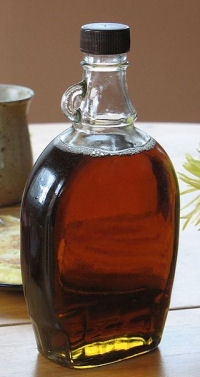
Bottled Maple Syrup
The Evening Observer, Dunkirk, N. Y., reported that a confident Governor Harriman was steadfastly convinced that no one could match the quality of New York's maple syrup.
Harriman obviously does not think this is possible for he has put up a "Governor's Cup" to be awarded in competition at the State Sugar Festival in Cooperstown next April.
Brimming with confidence, the Governor's office said Saturday the competition would be open to all states and "friendly nations." Food editors will taste-test the syrup at the festival, which is scheduled for April 6-7.
("State's Maple Syrup "Best In World"-Ave", 1956)
?Announcement was made this week that Gov. Averell Harriman, New York State?s leading maple booster, has issued invitations to nine other states, and to the premier of Quebec, to attend the New York State Maple Festival at Cooperstown on April 6 and 7,? The Star reported on March 16. The festival would hopefully answer the question as to which state or province had the best maple syrup.
(Simonson, "Backtracking: In Our Times: Election, maple syrup, schools made local news in '56", 2016)
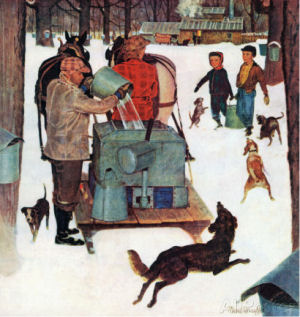
Maple Syrup Time in Vermont
Photographs, prints, posters
The taste-off at the New York State Maple Festival would include production from New York, Vermont, Pennsylvania, Massachusetts, Ohio, Wisconsin, Maine, Michigan, Minnesota and Canada's Quebec Province.
Meanwhile in Albany, on January 31, 1956, the New York Senate approved the bill proposing that the sugar maple tree be designated the official state tree and forwarded it to the Assembly for consideration.
The New York State Maple Sugar Festival and maple syrup taste-off loomed ahead. Both New York Governor Harriman and Vermont Governor Johnson remained certain that their state's product would come out on top.
Even prior to arriving at the festival, the judges, food editors Isabel McGovern, Mary Hornaday, Margaret Pettigrew, Alice Peterson and Ida Bailey Allen began making their way through various syrupy recipes including "maple barbecued ribs; sweet and sour skillet chicken; maple corn muffins; scalloped sweet potatoes and pineapples in syrup; French dressing with maple syrup; maple charlotte russe (a type of desert), and maple fluff." [3]
Evidently, their sensitive palates could not distinguish between two top contenders. Calling it a tie, they awarded the top spot to Vermont and Michigan. New York came in third.
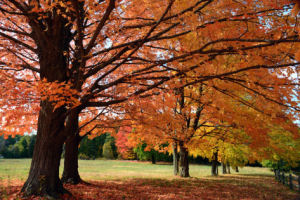
New York State Tree: Sugar Maple
Photographs, prints, posters
We have been unable to find ranking information for the remaining seven contestants; Pennsylvania, Massachusetts, Ohio, Wisconsin, Maine, Minnesota and Canada's Quebec Province.
The top products awards went to Dewey Lyman of "Breezy Hill Farm, White River Junction, Vermont, and Clive Willis, Bellevue, Michigan.
Governor Averell Harriman accepted the results graciously. Because there were two first-place winners, he promised to provide a Silver Governor's Cup to each.
Though Vermont came out ahead of New York this year, the victory was slight.
After the results of the competition were announced, undaunted, Governor Harriman went on to sign the tree bill, approved by the New York State Legislature, making the sugar maple the official state tree of the State of New York on April 10, 1956.
New York Law
The following information was excerpted from the Consolidated Laws of New York, STL - State, Article 6, Section 76.
STL - State
ARTICLE 6 - ARMS AND GREAT SEAL OF STATE
SECTION 76
§ 76. State tree. The sugar maple (Acer Saccharum M.) shall be the official tree of the state.
Sources...
"Cooperstown Invites Governors to Fete." Syracuse Herald-American 24 Jan. 1956: 32. Print.
[2] Dumas, Charles. "Sweet Sugar Maple Tree Is Cause of War Between States." Wellsville Daily Reporter 24 Jan. 1956: 1. Print.
[1] "Harriman Issues Challenge To Johnson For Taste-Test On Qualities Of Maple Syrup." Bennington Evening Banner 24 Jan. 1956: 1. Print.
"Highlighted in the News: Stickey Subject." The Lethbridge Herald 3 Feb. 1956: 1. Print.
"N. Hampshire Enters Maple Syrup Battle." Oneonta Star 13 Apr. 1956: 3. Print.
[3] "N.Y. Now Maple Tree State." Austin Daily Herald 6 Apr. 1956: 3. Print.
Shearer, Benjamin F. and Barbara S. State Names, Seals, Flags and Symbols: A Historical Guide Third Edition, Revised and Expanded. Westport, Conn: Greenwood Press, 3 Sub edition, 2001.
Simonson, Mark. "Backtracking: In Our Times: Election, Maple Syrup, Schools Made Local News in '56." The Daily Star. The Daily Star, 6 Mar. 2016. Web. 29 Nov. 2016.
"State's Maple Syrup "Best In World"-Ave." The Evening Observer [Dunkirk] 30 Jan. 1956: 3. Print.
"Vermont-N.Y. Maple Syrup Battle Simmering to Boil." The Transcript [North Adams] 24 Jan. 1956: 8. Print.
"Vermont Maples Are Tops Says GVA's Ansheles." The Evening Banner [Bennington] 23 Feb. 1956: 12. Print.
Additional Information
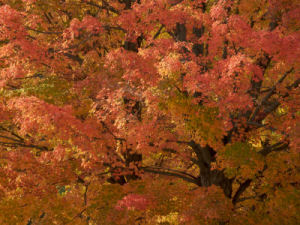
New York State Tree: Sugar Maple
Photographs, prints, posters
New York State Tree: New York State Library.
The life of a sugar maple tree: Cornell Sugar Maple Research & Extension Program.
Acer saccharum Sugar Maple Aceraceae: University of Connecticut Plant Database of Trees, Shrubs and Vines.
Sugar maple (Acer saccharum Marsh): Tree Identification Fact Sheet from the Virginia Tech.
Sugar maple (Acer saccharum Marsh): Landowner Fact Sheet from the Virginia Tech.
Plant Profile for Acer saccharum Marsh (sugar maple): USDA, NRCS. 2011. The PLANTS Database (http://plants.usda.gov, 20 January 2011). National Plant Data Center, Baton Rouge, LA 70874-4490 USA.
Acer saccharum Marsh (sugar maple): United States Department of Agriculture: Forest Service: Agriculture Handbook 654: Silvics of North America.
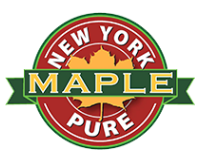
Visit The New York State
Maple Producers Association
CalPhotos Photo Database: Photographs of Acer saccharum from CalPhotos, a project of the Biodiversity Sciences Technology group (BSCIT), part of the Berkeley Natural History Museums at UC, Berkley.
Acer saccharum: Search for images of Acer saccharum with Google.
Website: The New York State Maple Producers Association.
Website: American Maple Museum, Croghan, New York.
State trees: Complete list of official state trees from NETSTATE.COM.
More symbols & emblems: Complete list of official New York state symbols from NETSTATE.COM.
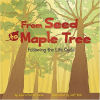
From Seed to Maple Tree
Laura Purdie Salas
From Seed to Maple Tree: Following the Life Cycle, by Laura Purdie Salas. 24 pages. Publisher: Picture Window Books (September 1, 2008) Reading level: Ages 4-8.
What does a seed need to grow? What color flowers does a sugar maple tree have? Let your mind bloom as you learn about the life cycle of a sugar maple tree.
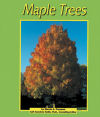
Maple Trees
Marcia S. Freeman
Maple Trees, by Marcia S. Freeman. 24 pages. Publisher: Capstone Press (September 1, 1998) Reading level: Ages 4-8.
Text and photographs describe the trunks, branches, leaves, seeds, and life cycle of maple trees.
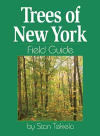
Trees of New York
Field Guide
Stan Tekiela
Trees of New York Field Guide, by Stan Tekiela. 260 pages. Publisher: Adventure Publications (May 10, 2006)
You don?t need to be an expert to appreciate trees. This field guide contains everything you?ll want to know, including full-page photos and detailed information about 118 species of New York trees, including each tree?s leaves or needles, bark, mature size, fall color, state-specific range map and more.
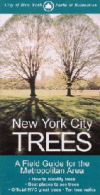
New York City Trees
Edward S. Barnard
New York City Trees: A Field Guide for the Metropolitan Area, by Edward S. Barnard. 240 pages. Publisher: Columbia University Press (September 15, 2002)
If you're not a tree lover now, this pocket-sized gem?dedicated to the idea that every species of tree has a story and every individual tree has a history?will make you one. Produced in consultation with the City's Parks and Recreation department and the New York Tree Trust, this book is a reference to the stories of New York City's trees, complete with photographs, tree silhouettes, leaf and fruit morphologies, and charming and informative explanatory texts. It is divided into four sections: "The Best Places to See Trees," full of insider's tips and helpful maps; "New York City's Great Trees," a directory of the oldest, strangest, most beautiful trees; "The Tree Guide," arranged for ease of identification by leaf shape and size; and, finally, "Sources and Resources" for future investigation..
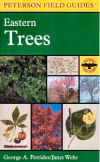
A Field Guide to
Eastern Trees
George A. Petrides
A Field Guide to Eastern Trees (Peterson Field Guides) , by George A. Petrides. 448 pages. Houghton Mifflin Harcourt; 2nd edition (July 15, 1998)
This field guide features detailed descriptions of 455 species of trees native to eastern North America, including the Midwest and the South. The 48 color plates, 11 black-and-white plates, and 26 text drawings show distinctive details needed for identification. Color photographs and 266 color range maps accompany the species descriptions.
A Field Guide to Trees and Shrubs, by George A. Petrides. 464 pages. Houghton Mifflin Harcourt; Second Edition edition (September 6, 1973)
All the wild trees, shrubs, and woody vines in the area north to Newfoundland, south to North Carolina and Tennessee, and west to the Dakotas and Kansas are described in detail. Accounts of 646 species include shape and arrangement of leaves, height, color, bark texture, flowering season, and fruit. Clear, accurate drawings illustrate leaves, flowers, buds, tree silhouettes, and other characteristics.
National Audubon Society Field Guide to North American Trees: Eastern Region, by Elbert Luther Little. 716 pages. Knopf; Chanticleer Press Ed edition (May 12, 1980)
Tree peepers everywhere will enjoy these two guides which explore the incredible environment of our country's forests-including seasonal features, habitat, range, and lore. Nearly 700 species of trees are detailed in photographs of leaf shape, bark, flowers, fruit, and fall leaves -- all can be quickly accessed making this the ideal field guide for any time of year.
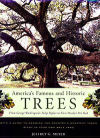
America's Famous
and Historic Trees
Jeffrey G. Meyer
America's Famous and Historic Trees: From George Washington's Tulip Poplar to Elvis Presley's Pin Oak
by Jeffrey G. Meyer. 130 pages. Houghton Mifflin Harcourt; First Edition (April 20, 2001)
America's Famous and Historic Trees tells the stories of various trees that Meyer and his cohorts rescued or propagated: oftentimes, when trees were going to be cut down, he and his workers headed off the bulldozers, rescuing the tree with their massive tree hoe. Other trees--like the Indian Marker Pecan in southeast Dallas--were propagated before they died.
Trees : National Champions
by Barbara Bosworth. 144 pages. The MIT Press; First Edition (August 19, 2005)
Bosworth captures the ineffable grace and dignity of trees with clarity and directness: the green ash that shades a Midwestern crossroads, the common pear that blooms in a Washington field, and the Florida strangler fig with its mass of entwining aerial roots. Her black and white photographs, panoramic views taken with an 8 x 10 camera, show the immensity of the largest species and the hidden triumphs of the smallest
Plants, Seeds & Flowers: Bulbs, seeds, plants, fertilizer, plant containers and more.
Gardening Tools: Pruners, rakes, shovels, hoes, trowels, cultivators and tillers, greenhouses, yard carts and more.

